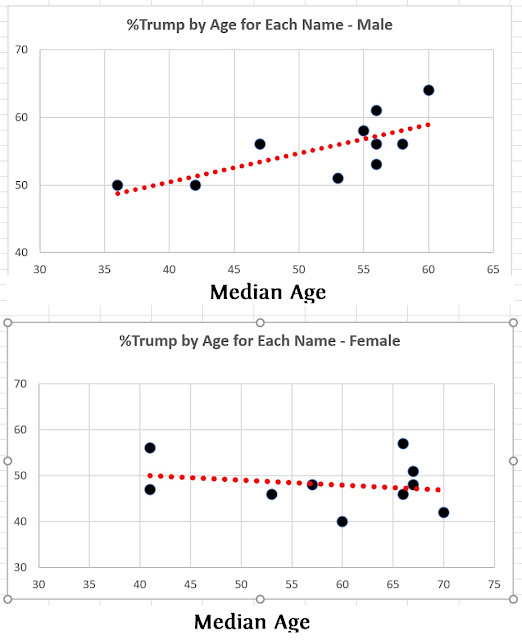November 2, 2020
Posted by Jay Livingston
The Times ran a quiz (here ) where you have to guess people’s voting preferences knowing only their names. For example,
The trick is to guess the correct demographic variable that goes with the name and with political preferences. If you know that Biden does much better among young voters and that Sarah skews younger (median age 33), this one’s easy. Similarly, Betty (median age 77) goes for Trump by a whopping 26 points.
But age isn’t the whole story. Here’s the Times chart of the most common male and female names, but I have added indicators showing the median age for each name.
markers by hand. Their location may be slightly off.)
Barbara may be old, median age 70, but she’s strongly for Biden. In fact, among these twenty names, it’s only among men that age goes with increasing support for Trump.
Of course, the most common names will be older. Today’s youthful Noahs and Emilys are the leading edge of those names. Not until they are older and with decades of as yet unborn Noahs and Emilys coming behind them will they outnumber Richard and Jennifer. The median age of these 20 names is 56 compared with the national median of 38.
The Times shows preferences of the 110 names worn by at least 30 people in the sample of 17,000. The most pro-Biden men are younger — Anthony (37), Samuel (27), Justin (32). But so are some of the most pro-Trump men — Aaron (32), Ryan (31), Joshua (36). The most pro-Biden guy is Patrick; he favors Biden by a 42-point margin.
Among women, the most pro-Biden is also one of the oldest. Dorothy (age 79) favors Joe by better than two to one. Following her are Catherine (58), Margaret (69) and Jane (68). But the most pro-Trump women (Cheryl, Debra, and Donna) are also in their mid-sixties.
Gender and median age for a name are easy to know. Race and social class, not so much. But in a few cases, these peek through. The Times notes that Debra goes for Trump by 24 points, Deborah leans to Biden by 10 points. The age distribution of these names is almost identical.
But there’s a social class difference. “Debra is a trendier spelling that . . .was more popular with younger parents, often those without a college degree. Deborah. . .is the sort of old-fashioned name that appeals to older parents with bachelor’s degrees, especially in the Northeast.” I would also hazard a guess about Tiffany and Taylor on the one hand, Maura and Margot on the other.




